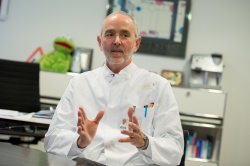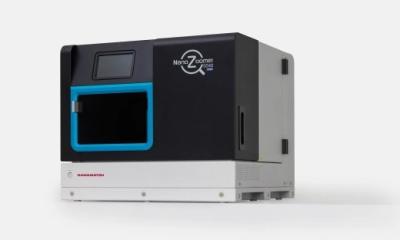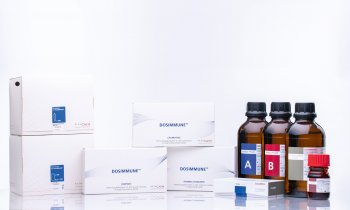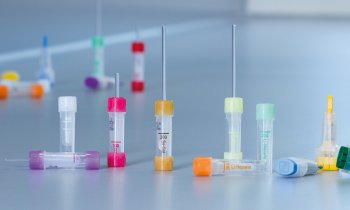Norms & standards
IT communication fosters unified standards
Looking back, the founding fathers of laboratory medicine were doctors who carried out the historic medical practice of uroscopy in the Middle Ages, explains Professor Klaus Kohse MD, Director of the Institute for Laboratory Medicine in Oldenburg Clinical Centre at Oldenburg University Medical Faculty.
Report: Walter Depner

‘They drew conclusions about a patient’s state of health by analysing a person’s urine – an easily accessible body fluid. The change to the use of blood for this type of analysis, along with improvements to analytics, was decisive for progress in this field, particularly in the last century,’ Kohse adds.
‘This information carrier is transported to all organs via the circulation and carries out an intensive exchange of substances. Examinations were carried out with increasingly sensitive procedures and extended to more and more physiological and pathological substances with increasing complexity. The ability to determine concentrations on a femtomolar level is no longer sensational, and for cells or genome equivalents the number required for safe quantitative and qualitative analysis can be counted on the fingers of just one hand.’
Where we are today
‘These days, the knack of laboratory medicine lies in the ability to process the enormous abundance of information from examinations. The ‘omics’, the entirety of genes, proteins, lipids, carbohydrates or metabolic parameters can now only be captured with bio-informatic methods. Traditional assessment criteria, such as longitudinal studies or transversal studies, soon reach their limits.
‘Going forward, the aforementioned, complex information will facilitate individual assessments along the lines of the much-heralded ‘personalised medicine’ – but only if we also realise that we are dealing with dynamic organisms, with any samples taken only giving us a snapshot of a situation at this very point in time. Last, but not least, diagnostics will be advanced through the integration of clinical-chemical information with imaging procedures – such as functional NMR, PET and so on.’
Having been a member of various national and international committees, associations and societies, among others the Executive Committee of the IFCC Task Force on Paediatric Laboratory Medicine. With roles also including treasurer of the European Communities Confederation of Clinical Chemistry and lecturer at the European Medical School Oldenburg-Groningen, the professor’s experience is pan-European. How does he perceive this array of countries and cultures?
‘The development of Europe from a plethora of different national states has obviously led to a multitude of developments during the establishment of our discipline,’ he points out. ‘Clinical Chemistry, Clinical Biochemistry, Clinical Biology, Clinical Pathology, and Laboratory Medicine are terms that tend to be used on a mix and match basis.
‘The scope of diagnostic activity is also extremely different. In one country the fields of haematology and microbiology are included, in another they are considered to be separate subjects. The medical degree courses also differ. There is human medicine on the one side and natural sciences, such as chemistry, biochemistry and pharmaceutics, on the other. The basic problem of how to deal with this continues to be an issue for the ‘community’.
‘This prevails despite the fact that there are European committees such as the European Federation of Clinical Chemistry and Laboratory Medicine (EFLM) and Union Européenne des Médecins Spécialistes (UEMS), which have agreed on and compiled fundamental documentation and competency descriptions, such as the term European Specialist in Clinical Chemistry and Laboratory Medicine, based on a ‘common platform’ type of catalogue.’
‘The differences don’t stop at European borders, but have to be assessed differently as a matter of principle against the background of different legislations beyond the European Union. The International Federation of Clinical Chemistry and Laboratory Medicine (IFCC) and the World Association of Pathology and Laboratory Medicine (WAsPaLM) are also working towards the creation of job profiles that are standardised worldwide and with comparable competencies. Not all partners are always weighted equally, which is partly due to sheer size – the American Association of Clinical Chemistry (AACC), for instance, is only one of 85 specialist associations involved, but it has a huge number of members – and partly also for legal reasons.’
The future is not gloomy
In no way is the view towards international harmonisation gloomy, according to Prof. Kohse. ‘When it comes to the contents of our activities, there are now hardly any national differences. There are procedures recommended by the international specialist associations and societies for the most important determination methods. The subject of quality assurance is basically handled in a very similar way the world over, although subtle differences will continue, due not least to different philosophies (such as target values for reference methods vs. consensus on target values for inter-laboratory test samples).
‘Standards organisations on a national (DIN), European (EN) and international (ISO) level also make significant contributions towards standardisation and harmonisation. They determine important specifications. For instance, one noticeable example is the definition of a unified standard for the competency of medical laboratories, which is implemented via accreditation with ISO-Norm 15189.
‘All of this only works because these days we can communicate in unbelievably fast and efficient ways. Sharing activities in internet presentations, along with electronic communication, enables international discussions with colleagues.’
24.04.2015











